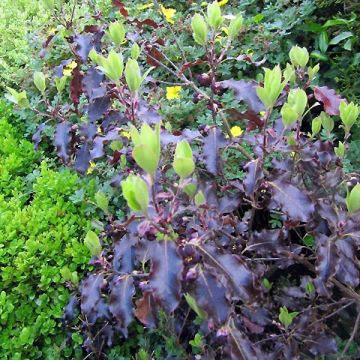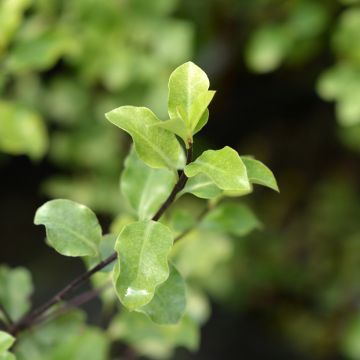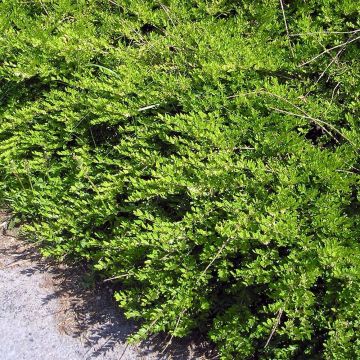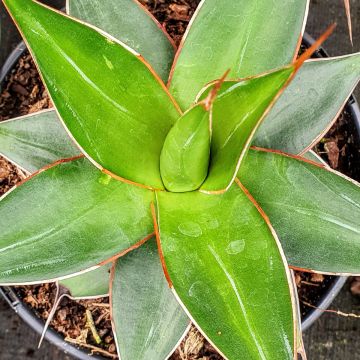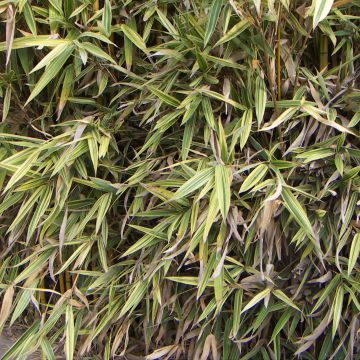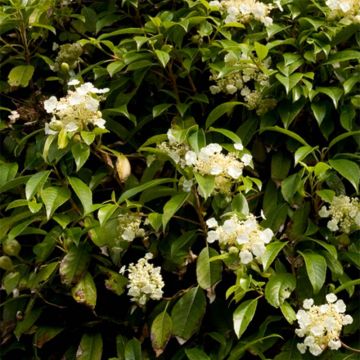

Pittosporum tenuifolium Gold Star - Kohuhu
Pittosporum tenuifolium Gold Star - Kohuhu
Pittosporum tenuifolium Gold Star
Tawhiwhi, Kohuhu, Black Matipo, New Zealand Pittosporum
Why not try an alternative variety in stock?
View all →This plant carries a 24 months recovery warranty
More information
We guarantee the quality of our plants for a full growing cycle, and will replace at our expense any plant that fails to recover under normal climatic and planting conditions.
From €5.90 for pickup delivery and €6.90 for home delivery
Express home delivery from €8.90.
Does this plant fit my garden?
Set up your Plantfit profile →
Description
Pittosporum tenuifolium 'Gold Star' is an ornamental variety known for its very bright variegated evergreen foliage. In spring, its young shoots are very bright before turning reddish-brown and then black, creating a striking contrast against its golden appearance. The foliage is a mass of small, leathery, ovate, and glossy leaves in a very light yellow colour, enhanced by a large white central vein and irregular dark green margins. It forms a medium-sized shrub with a dense and compact habit, particularly useful for creating year-round privacy hedges. In summer, its tiny blackish-purple flowers gather in inconspicuous clusters but release a strong honey-scented fragrance, especially during warmer nights. Due to its low hardiness and resistance to drought and salt, it is an ideal shrub for Mediterranean gardens and coastal gardens. Plant it in a sheltered sunny spot, in neutral to alkaline, well-drained soil. Elsewhere, grow it in a container on a balcony or patio and bring it indoors before the frosts arrive.
This shrub belongs to the Pittosporaceae family and is native to dry regions located east of the New Zealand Alps. The 'Gold Star' variety gradually forms a very dense, bushy, and compact shrub that reaches 2m (7ft) in height and 1.50m (5ft) in width. Its slender branching stems are initially bright green before turning reddish-brown and then black. They bear evergreen, alternate, entire, ovate, thick, glossy, leathery leaves with undulate edges. The leaves are small, measuring no more than 3 to 4 cm (1 to 2in) in length and 1.5 to 2 cm (1in) in width. They are yellow, illuminated by a pure white central vein and bordered by irregular dark green margins. The flowers occurs from May to June. The small star-shaped flowers, less than 1 cm (1in) in diameter, discreetly emerge from the axils of the leaves and emit a honey-scented fragrance, especially noticeable at night. They are followed by the formation of a few round fruits that start green and then turn almost black when ripe.
Hardy up to -7C°/-10C°, Pittosporum 'Gold Star' requires a dry, not too chalky, well-drained soil and a warm, sunny position protected from prevailing winds. It is preferable to grow it in a pot in climates where the winter is very cold. In mild climates, it can be planted in the back of a border in groups of 3 to 5 or as a standalone specimen. With its exceptionally dense habit, this variety can be used to quickly create beautiful, long-lasting, and highly resistant hedges for coastal or dry gardens. In colder regions, it can be grown in a container on a terrace to enjoy its delicate fragrance and Mediterranean charm. Pair it with perennial geraniums, lavenders, rosemary, Grevillea, Escallonia, or combine it with the silvery foliage of Artemisia.
Report an error about the product description
Pittosporum tenuifolium Gold Star - Kohuhu in pictures


Plant habit
Flowering
Foliage
Botanical data
Pittosporum
tenuifolium
Gold Star
Pittosporaceae
Tawhiwhi, Kohuhu, Black Matipo, New Zealand Pittosporum
Cultivar or hybrid
Other Pittosporum
Planting and care
Pittosporum 'Gold Star' should preferably be planted in spring in a cold climate, or in September-October in mild climate. Plant it in a fertile, dry, not too chalky and well-drained soil. At planting, mix leaf compost and coarse sand with your garden soil, up to 50%. Water your plant well once or twice a week to promote good root growth. Not very hardy , to -7°C (19.4°F), choose a warm location, in full sun which is sheltered from prevailing winds. Keep the base of the plant mulched. Plant it along a south-facing wall in regions with harsh winters. In cooler climates, cover it with a winter veil or shelter it in a frost-free conservatory for the winter season. To help it branch out during the first years of planting, pinch the young shoots. Prune mature plants at the end of the season, removing the branches that appear untidy. It is entirely possible to shape it into a ball or a hedge, as it tolerates pruning well.
Planting period
Intended location
Care
This item has not been reviewed yet - be the first to leave a review about it.
Evergreen shrubs
Haven't found what you were looking for?
Hardiness is the lowest winter temperature a plant can endure without suffering serious damage or even dying. However, hardiness is affected by location (a sheltered area, such as a patio), protection (winter cover) and soil type (hardiness is improved by well-drained soil).

Photo Sharing Terms & Conditions
In order to encourage gardeners to interact and share their experiences, Promesse de fleurs offers various media enabling content to be uploaded onto its Site - in particular via the ‘Photo sharing’ module.
The User agrees to refrain from:
- Posting any content that is illegal, prejudicial, insulting, racist, inciteful to hatred, revisionist, contrary to public decency, that infringes on privacy or on the privacy rights of third parties, in particular the publicity rights of persons and goods, intellectual property rights, or the right to privacy.
- Submitting content on behalf of a third party;
- Impersonate the identity of a third party and/or publish any personal information about a third party;
In general, the User undertakes to refrain from any unethical behaviour.
All Content (in particular text, comments, files, images, photos, videos, creative works, etc.), which may be subject to property or intellectual property rights, image or other private rights, shall remain the property of the User, subject to the limited rights granted by the terms of the licence granted by Promesse de fleurs as stated below. Users are at liberty to publish or not to publish such Content on the Site, notably via the ‘Photo Sharing’ facility, and accept that this Content shall be made public and freely accessible, notably on the Internet.
Users further acknowledge, undertake to have ,and guarantee that they hold all necessary rights and permissions to publish such material on the Site, in particular with regard to the legislation in force pertaining to any privacy, property, intellectual property, image, or contractual rights, or rights of any other nature. By publishing such Content on the Site, Users acknowledge accepting full liability as publishers of the Content within the meaning of the law, and grant Promesse de fleurs, free of charge, an inclusive, worldwide licence for the said Content for the entire duration of its publication, including all reproduction, representation, up/downloading, displaying, performing, transmission, and storage rights.
Users also grant permission for their name to be linked to the Content and accept that this link may not always be made available.
By engaging in posting material, Users consent to their Content becoming automatically accessible on the Internet, in particular on other sites and/or blogs and/or web pages of the Promesse de fleurs site, including in particular social pages and the Promesse de fleurs catalogue.
Users may secure the removal of entrusted content free of charge by issuing a simple request via our contact form.
The flowering period indicated on our website applies to countries and regions located in USDA zone 8 (France, the United Kingdom, Ireland, the Netherlands, etc.)
It will vary according to where you live:
- In zones 9 to 10 (Italy, Spain, Greece, etc.), flowering will occur about 2 to 4 weeks earlier.
- In zones 6 to 7 (Germany, Poland, Slovenia, and lower mountainous regions), flowering will be delayed by 2 to 3 weeks.
- In zone 5 (Central Europe, Scandinavia), blooming will be delayed by 3 to 5 weeks.
In temperate climates, pruning of spring-flowering shrubs (forsythia, spireas, etc.) should be done just after flowering.
Pruning of summer-flowering shrubs (Indian Lilac, Perovskia, etc.) can be done in winter or spring.
In cold regions as well as with frost-sensitive plants, avoid pruning too early when severe frosts may still occur.
The planting period indicated on our website applies to countries and regions located in USDA zone 8 (France, United Kingdom, Ireland, Netherlands).
It will vary according to where you live:
- In Mediterranean zones (Marseille, Madrid, Milan, etc.), autumn and winter are the best planting periods.
- In continental zones (Strasbourg, Munich, Vienna, etc.), delay planting by 2 to 3 weeks in spring and bring it forward by 2 to 4 weeks in autumn.
- In mountainous regions (the Alps, Pyrenees, Carpathians, etc.), it is best to plant in late spring (May-June) or late summer (August-September).
The harvesting period indicated on our website applies to countries and regions in USDA zone 8 (France, England, Ireland, the Netherlands).
In colder areas (Scandinavia, Poland, Austria...) fruit and vegetable harvests are likely to be delayed by 3-4 weeks.
In warmer areas (Italy, Spain, Greece, etc.), harvesting will probably take place earlier, depending on weather conditions.
The sowing periods indicated on our website apply to countries and regions within USDA Zone 8 (France, UK, Ireland, Netherlands).
In colder areas (Scandinavia, Poland, Austria...), delay any outdoor sowing by 3-4 weeks, or sow under glass.
In warmer climes (Italy, Spain, Greece, etc.), bring outdoor sowing forward by a few weeks.


































